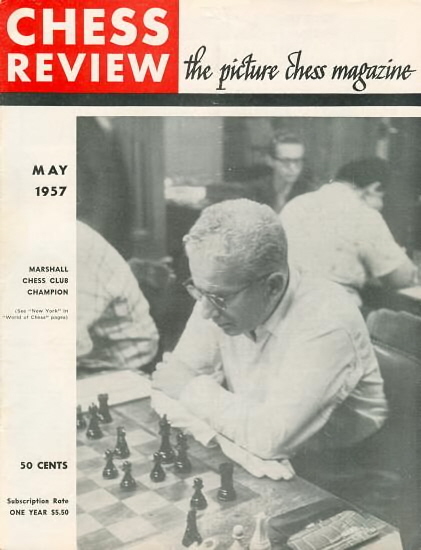
Edward Winter
(2004, with updates)

In 1992 the chess world lost an American master who, born in 1911, enjoyed a lengthy career which included games against Lasker, Capablanca, Alekhine, Rubinstein and Fischer. We are thinking not of Samuel Reshevsky but of a neglected figure whose obituary appeared on the same page as Reshevsky’s in the June 1992 Chess Life (page 456): Sidney N. Bernstein.
His career was well chronicled in his book Combat: My 50 Years at the Chessboard (Atlantis Press, Ltd., New York, 1977), but he was an infrequent writer on the game and was deeply involved in only two other volumes. In the late 1930s he co-edited with Fred Reinfeld a book on Kemeri, 1937, and in 1947 the two collaborated on a revision of James Mason’s The Art of Chess.
Sidney Bernstein was an ardent supporter of Chess Notes, and we received many letters from him replete with reminiscences on his career and comments about topical chess events. For example, concerning the controversy about whether Reshevsky on Chess (New York, 1948) was ghosted by Reinfeld (see pages 321-322 of Kings, Commoners and Knaves), Bernstein informed us on 25 September 1986:
‘I was a close friend of Reinfeld – and, for what it’s worth, he confided to me that he had indeed written the Reshevsky book. (He was, as you may well have surmised, a prolific ghost-writer – and “did” other books by great players, including Frank Marshall.) Marshall, incidentally, was a delightful, lovable gentleman as well as a chess genius.’
Reinfeld and Bernstein were eventually to fall out, as he explained to us in a letter dated 15 October 1988:
‘I was working for Fred as an analyst (chess) in the 1950s. After some time he complained about my work. That upset me, which was noticed by my wife (a Russian Jewish lady who was a fairly good player). Unbeknownst to me, she wrote him an unfriendly note – whereupon there was no further friendship or collaboration between us (Fred and myself, I mean). He was a brilliant man, and we had been fast friends. The above explains why I’ve never known what was behind the break between him and Horowitz. I have no details whatever about the indubitable rift between them.’
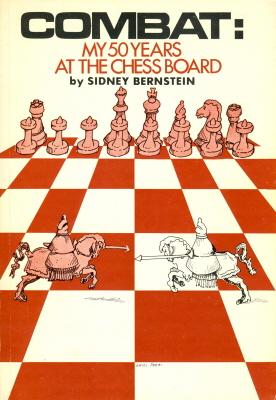
An uncommon feature of Combat: My 50 Years at the Chessboard was referred to in C.N. 1613 (see page 380 of Kings, Commoners and Knaves): the author’s voluntary omission of any diagrams (which he regarded as ‘anachronistic and wasters of space’ that encouraged readers ‘to “skim” a book’s contents’). As regards the selection of games he informed us on 28 November 1986:
‘Perhaps the most satisfying games are vs. Cass (page 13), Donovan (page 15), Seidman (page 30) Hoffman (page 37), Pavey (page 48), Gresser (page 62), Seidman (again) (page 63), Braczko (page 78), Tol (page 85), Benjamin (page 106).’
All these games can be found in databases, where we have seen the Cass game incorrectly given as a draw, rather than as a win for Bernstein. On 19 October 1986 he told us that although his book covered the period 1927-77 ‘the best game I ever played (attached) occurred in 1978’. It was presented in C.N. 1515 (see also pages 60-61 of Chess Explorations), and below is the score-sheet which he sent us:
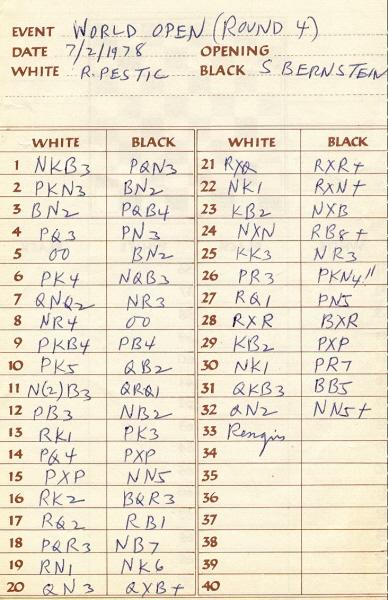
On 4 March 1988 he wrote:
‘Enclosed is a recent game I played against a master who is one of the top teachers of children in the US. (Due to illness, it was my only game in the event.)’
Sidney Norman Bernstein – Sunil Weeramantry
NY State Championship, 6 September 1987
King’s Indian Defence1 Nf3 g6 2 c4 Bg7 3 g3 d6 4 d4 Nf6 5 Nc3 O-O 6 Bg2 Nc6 7 h3 (‘In our last encounter, I allowed 7…Bg4 and eventually lost.’) Nd7 8 b3 e5 9 Bg5 f6 10 Be3 h6 11 Qd2 Kh7 12 g4 Nb6 13 Rc1 Ne7 14 dxe5 dxe5 15 Bc5 Nd7 16 Ba3 Rf7 17 h4 c6 18 h5 g5 19 Ne4 (‘Here I must digress. No doubt I’m insane, but over many years I’ve come to feel that even the world’s greatest players (Karpov included) misplay the white side of the King’s Indian by an early e4. This blocks the fianchettoed bishop (as Black will certainly play …e5), allows a “hole” at d4 and forfeits the option of using the square e4 as a transfer spot (for example, my last move). I’ve always kept the e-pawn at home with the option of e3 if needed – and have scored numerous wins in that fashion. Incidentally, when Black has played 6…Nbd7 rather than the “Yugoslav” 6…Nc6 as in this game, I’ve been most successful with 7 Bf4.’) 19…Bf8 20 Nd6 Rg7 21 Nh2 Ng8 22 Be4+ Kh8 23 Nf1 Bxd6 24 Qxd6 Qa5+ 25 Qb4 Qb6 26 Ne3 a5 27 Qxb6 Nxb6 28 c5 Nd7 29 Nf5 Rf7 30 Rh3 Nf8 31 Rd3 Bxf5 32 Bxf5 Ne7 33 Be4 Ne6 34 Rd7 Rb8 35 Rcd1 Kg7 36 e3! Kf8 37 R7d6 Nc7 38 Rd8+ Rxd8 39 Rxd8+ Kg7 40 Rb8 Nb5 41 Bb2 Nd5 42 Bg6 Re7 (‘If 42…Rd7? 43 Bf5!’) 43 Ra8 e4 44 a3 Ndc3 45 Bxc3 Nxc3 46 Bf5 a4 47 bxa4 Re5 48 Ra7 Rxc5 49 Rxb7+ Kf8 50 Kf1 Nxa4 51 Bxe4 Rc1+ 52 Kg2 c5 53 Rh7 c4 54 Rxh6 Nc5 55 Bf5 Resigns.
His above-mentioned encounters with Lasker, Capablanca, Alekhine and Rubinstein were all in simultaneous displays, and regarding the Cuban he wrote to us on 17 April 1987:
‘I first saw him when I visited the 1927 N.Y. tourney – he radiated more animal magnetism than any person I ever met. Years later we were introduced at the Marshall Club. ... I was one of 41 players opposing Capa at the Brooklyn Academy of Music in 1928 (I think). After the “demise” of the other 40, Capa and I “were head to head”. I had played the Budapest Defense (my favorite of those years), and the game was one of the most exciting I’ve ever been involved in. Capa threw caution to the winds, castling queen’s [side] and allowing me to fork his rooks at f2 and win the exchange. But he attacked viciously (fiendishly) and chased my king all over the board. How I survived was a miracle – the black monarch finally ended up on the queen’s side and the queens were exchanged. In the ending his knight was unassailably installed at d5, while I had a rook. He had five pawns, all connected; I had four, also connected. There were no passed pawns. He proposed a draw, which I turned down. He became very angry – seems he had a ship to catch for Havana, and started to curse at me in Spanish. ’Twas about 3.30 a.m. and I finally relented. But one of the greatest tragedies of my chess life is that I don’t have the score of this drawn game.’
We informed him of the following paragraph on page 175 of the December 1928 American Chess Bulletin:
‘In his exhibition at the Brooklyn Institute Chess Club on 1 December Capablanca played 46 games, winning 43 and drawing 3. His successful opponents were Dr G.W. Averill, L.H. Campbell and S. Bernstein. Last February, at the same club, Capablanca won 44 and drew 3.’
In passing we also pointed out that in its report of the earlier event the Bulletin (February 1928 issue, page 30) gave the venue as the Brooklyn Institute of Arts and Sciences. In letters dated 29 April and 29 May 1987 Bernstein told us:
‘I kept the score during the game, of course – but later lost it. Quel malheur. I definitely recall that Capa won all the games besides mine (40).’ ... ‘I assumed (apparently incorrectly) that since Capa and I were playing head to head he had defeated all his other opponents in the simul. And you’re no doubt correct as to the venue ...’
The moves of Bernstein’s draw with Capablanca eventually came to light and were published on page 243 of The Games of José Raúl Capablanca by R. Caparrós (Yorklyn, 1991), subsequently being included in databases. However, in view of Bernstein’s description it may be wondered whether there were additional moves beyond 37 a4.
Another encounter in a simultaneous exhibition was mentioned by Bernstein on 25 September 1986:
‘I did play (and won, in 21 moves) vs. Akiba Rubinstein in the late 1920s (I believe) but have been unable to find the score as yet.’
Played at the Brooklyn Chess Club on 23 April 1928, the game was given on page 265 of Akiba Rubinstein: The Later Years by J. Donaldson and N. Minev (Seattle, 1995). A score available in databases is Bernstein’s loss to Emanuel Lasker in a clock simultaneous display at the I.L. Rice Progressive Chess Club in New York on 8 November 1928. As reported on page 181 of the December 1928 American Chess Bulletin, Lasker scored +7 –2 =1. He was nearly 60, and Bernstein was 17.
On 21 September 1988 Bernstein informed us that he had been on the move:
‘I took a short vacation in Paris and Brussels ... My ambition (now realized) was to see once more, before I die, the marvelous Jardin du Luxembourg, where I spent many happy hours while a student at the Sorbonne (in 1932-5).’
Mention of the Sorbonne prompted us to raise the subject of Alekhine with him, and on 15 October 1988 he replied:
‘I know nothing about studies by Alekhine at the Sorbonne. I do know that I played once against him in a simul he gave while I was in Paris (adopting the Alekhine Defense out of deference to my illustrious opponent, I was smashed, though I do not have the score or the date, which was probably sometime in 1934). I remember how impressed I was by his bearing and handsome, dashing appearance.’
That game-score has not been found.
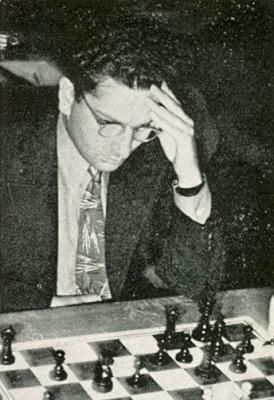
Sidney Bernstein (Chess Review, June-July 1940, page 101)
Our letters also discussed his namesake Jacob Bernstein, a rather mysterious player who participated in the great Carlsbad, 1923 tournament. Below is a compilation of S.B.’s comments:
‘I met Jacob Bernstein (who had completely given up chess and was running a gambling parlor) when I was in my prime. He seemed very old to me. We played some offhand games (I was never much good at offhand play) and he trounced me mercilessly – I must have scored 2 or 2½ points out of 15 or 20’ (17 April 1987). ‘I don’t know the exact address of the “dive” where I met Bernstein – it was on E. 14th St in Manhattan between 4th and 3rd Aves. ... Jacob Bernstein was Jewish and probably died in 1959’ (29 April 1987). ‘The “chess club” I visited when Jacob Bernstein drubbed me was actually a gambling house. On my second visit, I played chess with the youngster Tobias Stone, who later became (and still is, no doubt) a world-renowned bridge player who achieved notoriety by accusing the famous Italian team of cheating ... Anyway, in the middle of play, the police raided the place, confiscating lots of gambling equipment and arresting everyone but us. And I remember Jacob Bernstein complaining loudly that under Mayor LaGuardia it was impossible any longer to “make a living” because the police could no longer be bribed’ (16 May 1987). ‘I do remember that one of the famous habitués there was Abraham Kupchik (the most “neglected” and underrated player in US history – on the occasion of the Manhattan Chess Club centenary celebration a few years ago Chess Life did not mention the fact that he had won the club championship 11 times). I just learned last month from IM Walter Shipman that he (Kupchik) was most unhappy at not being chosen for the US team that journeyed to Moscow (in the 1950s). I was picked (though I did not go) and I find it interesting in retrospect that I have never given a thought to the fact that he was overlooked in my favor. He was a completely insignificant personality – at least on the surface’ (29 May 1987).
On 28 November 1986 Sidney Bernstein provided information about the murder committed by Raymond Weinstein (text given in C.N. 1311):
‘I have it on most reliable authority (the author John Collins, who was a close friend of Raymond Weinstein) that Weinstein (an extremely strong and promising young player who finished third in the 1960-61 US Championship) had been confined to a mental institution. While on temporary leave, he was rooming with an older man who made derogatory remarks about Weinstein’s mother. Raymond slit the man’s throat with a razor, and was, of course, incarcerated permanently. Raymond’s mother is also in an asylum.
Incidentally, Raymond once invited me to lunch at his home (before the above troubles, of course). His father, who was also present, struck me as a terrible person who tyrannized and terrorized the family. He was a good chessplayer, but talked incessantly about the golf trophies he had won. In retrospect, it was easy to understand why Raymond and his mother were committed.’
As indicated on pages 183-184 of our book (from C.N. 1403), Bernstein also assisted us in trying to sort out the claim by Reuben Fine on page xviii of Lessons from My Games that ‘Bogoljubow had some of his rivals put in concentration camps by the Nazis when they arrived on the scene in Germany’. Below is an expanded account of the affair.
On 23 January 1987 he informed us:
‘Yes, I know Dr Ruben (he spells it thus now) Fine – we went to university together back in the 1930s. He was even then a very brilliant youngster – I recall that after school hours he would give lectures on Symbolic Logic. I haven’t been in touch with him in recent years, but I can give you his current address and phone ...’
On 12 February 1987 we duly wrote the following letter:
‘Dear Dr Fine,
In the November-December 1983 issue of my magazine I quoted your comment about Bogoljubow on page xviii of Lessons from My Games, “Bogoljubow had some of his rivals put in concentration camps by the Nazis when they arrived on the scene in Germany”, and asked what evidence existed for the claim and who were the victims.
Although Chess Notes is read in nearly a hundred countries, nobody has been able to shed any further light on the matter, and I therefore take the liberty of writing to you direct to ask if you could kindly inform me of the source of your information.
It is a delicate matter, of course, but I hope that the enclosed sheet [of testimonials] will show that my magazine can be relied upon to handle issues responsibly.
Your reply will be greatly appreciated.
Yours sincerely,
Edward Winter’
No response was received from Fine, and on 17 April 1987 Bernstein wrote to us:
‘As for Fine – when you originally expressed interest in the matter of Bogoljubow’s activities related to the “concentration camps” I telephoned him. He wasn’t available, so I left my phone number on his tape. But he never returned my call – that’s why I sent you his address. Today, upon receipt of your letter, I phoned him again – and was able to reach him. He stated that he recalled getting your enquiry, but ignored it as he assumed you were “some kind of nut” (his words!). I assured him that he was in error ... Anyway, I brought up the Bogoljubow concentration camp matter. He stated: “Everyone knows he was a Nazi.” I pressed him for details of Bogoljubow’s misdeeds. The only person he could name as having been sent to a camp by Bogoljubow was Dr Seitz (who was, I believe, a chess journalist). Perhaps he (Fine) doesn’t recall the names of those who he alleges were victims ...’
In view of Fine’s inadequate response (as Chess Notes was later to report, Seitz was not even in Europe during the Second World War) we asked Bernstein to press him further. He kindly did so, reporting on 29 April 1987:
‘I’ve phoned Dr Fine’s office per your request and left a message on his answering-service tape. I hope the curmudgeon contacts me ...’
He did not. Bernstein wrote to us on 15 October 1988, ‘my feeling is that he has no remaining interest in chess matters’. On 3 January 1989 he referred to ‘his rather childish nature’, and on 26 January 1989 he commented:
‘Dr Fine is (to me) inscrutable – he and I were college students at the same time, same institution, and I always considered him a strange person …’
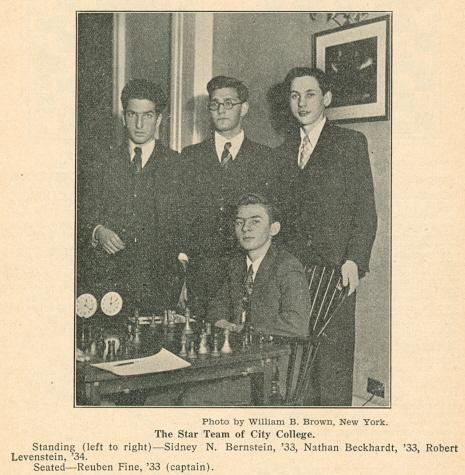
American Chess Bulletin, January 1932, page 16
Our correspondence was not confined to historical matters. On 28 March 1988 Bernstein wrote:
‘If you are asked to make a choice, who would you pick to become Kasparov’s next challenger? I’m disappointed by the failure of Ljubo to reach the Candidates – I consider him [one] of the world’s most creative (not successful) players.’
During the mid- and late-1980s the journalistic standards of certain UK and US chess magazines fell to a lamentable low, and Bernstein commented to us on 10 February 1988:
‘The last few issues of Chess Life seem to me to be “tales told by an idiot”. It is difficult to comprehend how so much vitriolic material can be contained in such a small space. Everyone seems to be attacking someone else – and for me, at least, it is impossible to make any sense of the welter of conflicting statements. Meanwhile, I think chess has suffered.’
It was also the time of the Ricardo Calvo ‘persona non grata’ affair and FIDE’s attempts to introduce a Code of Ethics (the groundwork for which it entrusted to, of all people, Mr David Anderton of the British Chess Federation). We wrote in C.N. 1712: ‘FIDE exists to organize chess, not courts-martial against those with objectionable opinions.’ On 28 March 1988 Bernstein had commented to us, ‘I was quite impressed by Calvo’s letter (which brought so much opprobrium on him from the muck-a-mucks comprising chess officialdom). I think he “tells it like it is”.’ On 9 May 1988 he set out further views on this and other issues of the day:
‘As for Calvo – I object strenuously to anyone being persecuted for expressing his or her opinion. Whether Calvo was accurate is irrelevant (to me). The fact that some countries “wished to throw him out” suggests that perhaps he touched some sensitive nerves ...
I agree with you that something should be done about the permanence of FIDE titles. The latest oddity was the GM award (practically posthumously!) to Dake. While he was once quite strong, I know of no tourney success for him, and see his GM title as part of the FIDE “old boy” structure. (Incidentally, I played him eight times in tourneys – result was, I lost one, drew seven.)’
On 3 January 1989 he wrote, ‘Have received a copy of Seirawan’s Inside Chess (Vol. 1, issue 25) and found it excellent’. In contrast, Bernstein’s low opinion of the United States Chess Federation was unwavering and is best illustrated by a passage from his letter of 9 July 1988, in which he asked us for information about a tournament in Italy in which he wished to participate:
‘I could contact USCF, but have no confidence in those mediocre bureaucrats. ... Gisela Gresser (nine times Woman Champ. of the US, who is a legitimate candidate for the Hall of Fame but was denied entry to the last Women’s Champs. event by those USCF morons) enthused to me about this Italian tourney in Imperia – and I would love to play there. (Will take along my girl friend.)’
Sidney Bernstein was nearly 77 when he wrote those words, but there was no vestige of elderliness in any letter he wrote us. He was a wonderful man.
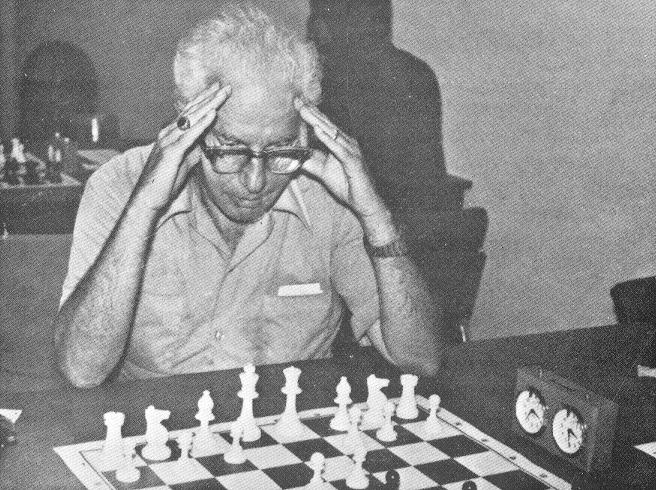
Sidney Bernstein
Concerning Capablanca’s draw against Sidney Bernstein in a simultaneous exhibition, Gerard Killoran (Ilkley, England) shows that when writing to us in 1987 (see above) Bernstein forgot not only certain details but also the fact that he had annotated the game on page 6A of the Brooklyn Daily Eagle, 27 December 1928. Mr Killoran provides the cutting:
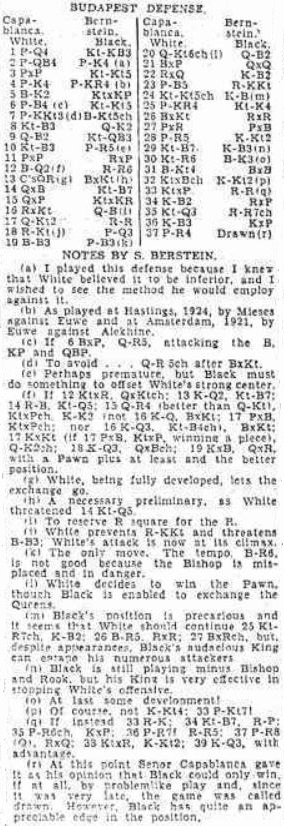
1 d4 Nf6 2 c4 e5 3 dxe5 Ng4 4 e4 h5 5 Be2 Nxe5 6 f4 Ng4 7 g3 Bb4+ 8 Nc3 Qe7 9 Qc2 Nc6 10 Nf3 h4 11 gxh4 Rxh4 12 Bd2 Rh3 13 O-O-O Bxc3 14 Qxc3 Nf2 15 Qxg7 Nxh1 16 Rxh1 Qf8 17 Qg2 Rh8 18 Rg1 d6 19 Bc3 f6 20 Qg6+ Qf7 21 Bxf6 Qxg6 22 Rxg6 Kf7 23 f5 Rg8 24 Ng5+ Kf8 25 h4 Ne5 26 Bxe5 Rxg6 27 fxg6 dxe5 28 h5 Kg7 29 Nf7 Kf6 30 Nh6 Be6 31 Bg4 Bxg4 32 Nxg4+ Kg7 33 Nxe5 Rh8 34 Kc2 Rxh5 35 Nd3 Rh2+ 36 Kc3 Kxg6 37 a4 Drawn.
White’s 34th move was recorded as 34 Kc2, and not 34 Kd2 (as given by Rogelio Caparrós’s books on Capablanca and, subsequently, in databases).
As mentioned in the present feature article, in 1986 Sidney Bernstein told us that the best game he ever played was against R. Pestic, Philadelphia, 1978. Now, Brian Lawson (Douglaston, NY, USA) has forwarded a letter from Bernstein dated 10 July 1982:
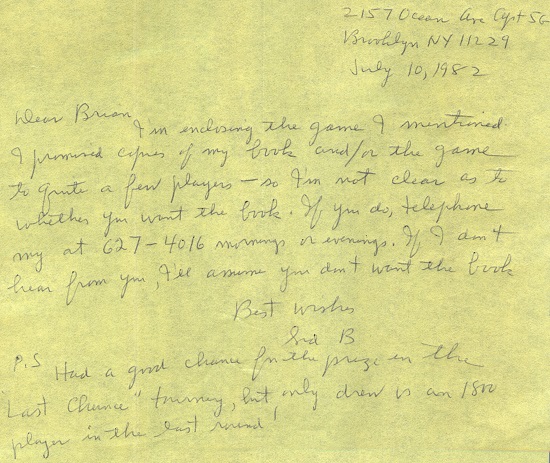
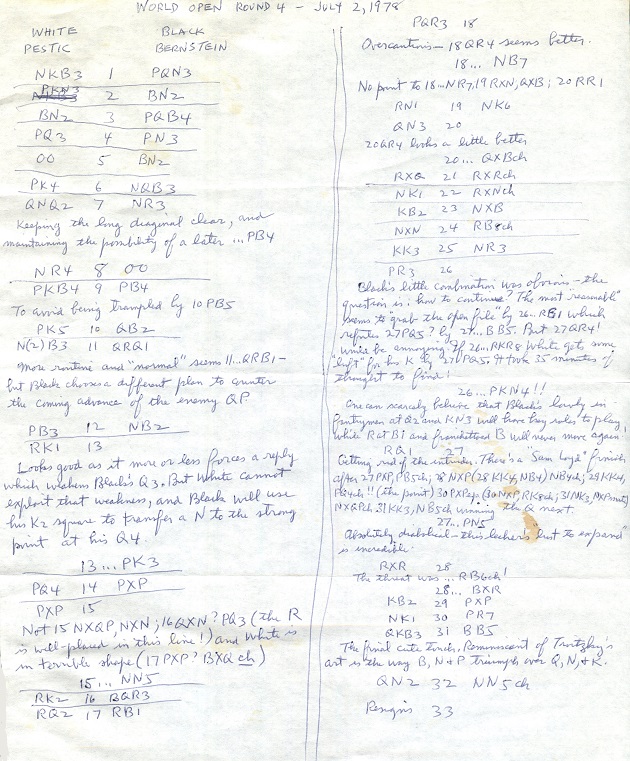
(9282)
Some writers have the peculiar habit of snippet-dangling ... : on page 1 of The United States Chess Championship, 1845-1996 by A. Soltis and G.H. McCormick (Jefferson, 1997) an aromatic morsel is waggled fleetingly under the reader’s nose. In a cursory list of some American chess masters’ professions, Sidney Bernstein is described as ‘a movie censor’. Nostrils atwitch, the reader hopes for some hard facts, but the book has already moved on to calling Jackson Showalter a cattle rancher. To rewind, though, what exactly is known about the assertion that Sidney Bernstein was a film censor? Where and when? Working for whom? In peacetime or in wartime, or both? Censoring what kind of films? What reliable source do the co-authors have for their tiny, if tantalizing, nibble?
When nothing is explained, everything and anything can be imagined; even, for instance, that – and stranger things have happened in chess literature – there has been a mix-up over, say, Sydney Sharp or Jacob Bernstein. Only with the rewarding discipline of real sourcing can the writer aspire to real clarity and real precision, and that is what readers deserve.
(11583)
A photograph of Sidney Bernstein with Fred Reinfeld appeared on the front cover of the February 1942 Chess Review:
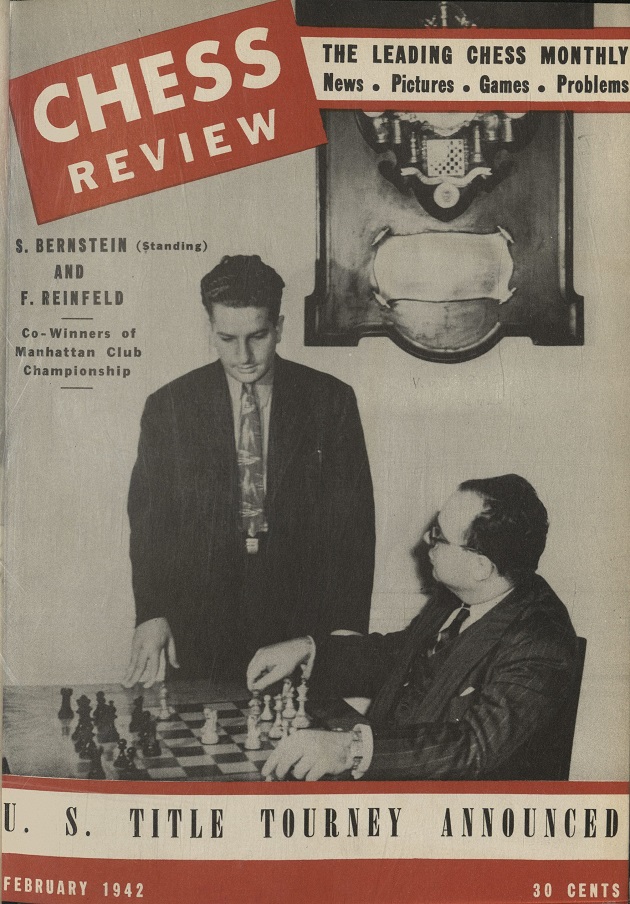
C.N. 931 gave the following brevity:
R. Chalker – Sidney Bernstein
New York (Continental Open), 1976
Queen’s Pawn Game
1 d4 d5 2 e4 dxe4 3 Nc3 e5 4 dxe5 Qxd1+ 5 Kxd1 Nc6 6 Nd5 Bg4+ 7 f3 O-O-O 8 c4 exf3 9 gxf3 Be6 10 f4 Rxd5+ 11 White resigns.
Source: Combat: My Fifty Years at the Chessboard by Sidney Bernstein (New York, 1977), page 101.
See also our feature article on Ossip Bernstein.
To the Chess Notes main page.
To the Archives for other feature articles.
Copyright: Edward Winter. All rights reserved.